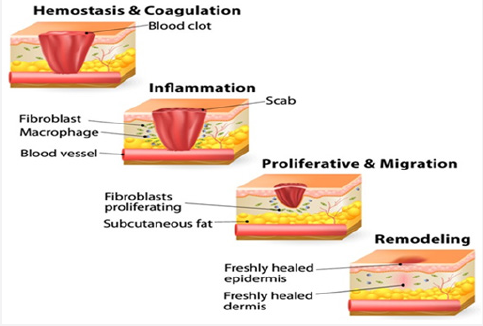Tissue healing

Inflammation Phase:
- Regulation of Inflammatory Signals: The balance of pro-inflammatory and anti-inflammatory signals is crucial. Cytokines like IL-1β and TNF-α heighten inflammation, whereas IL-10 and TGF-β help dampen the inflammatory response. The delicate equilibrium between these signals determines the progression or resolution of inflammation, impacting the healing trajectory.
- Barrier Restoration: Early in inflammation, re-establishing a barrier against pathogens is paramount. Epithelial cells rapidly proliferate and migrate to cover open wounds, a process underpinned by the reorganization of actin cytoskeleton and influenced by EGF and keratinocyte growth factor (KGF).
Proliferation Phase:
- Cell Proliferation and Differentiation: Beyond extracellular matrix (ECM) remodeling, this phase sees the proliferation of resident stem cells and their differentiation into cell types required for tissue repair, driven by signals such as Wnt/β-catenin and Hedgehog. This cellular diversity is essential for rebuilding the tissue architecture.
- Myofibroblast Activation: Myofibroblasts, arising from fibroblasts, play a pivotal role in wound contraction and ECM deposition. Their activation is stimulated by mechanical tension and TGF-β, highlighting the importance of mechanical signals in tissue repair.
Remodeling Phase:
- ECM Maturation and Tissue Elasticity: The final phase of healing not only strengthens the scar but also works towards restoring the elasticity of the tissue. Enzymatic cross-linking of collagen and elastin, orchestrated by lysyl oxidase (LOX), enhances tissue resilience and flexibility.
- Neurovascular Integration: For complete functional recovery, the reintegration of nervous tissue and the establishment of proper vascular networks are critical. Neurotrophic factors and angiogenic signals guide the growth of nerves and blood vessels, ensuring that the healed tissue is fully functional and integrated with the body’s physiological networks.
Regulation of Tissue Healing:
- Nutritional and Metabolic Factors: The healing process is energetically demanding. Adequate nutrition, particularly the availability of amino acids, vitamins, and minerals, supports collagen synthesis and immune function. Moreover, metabolic shifts towards aerobic glycolysis, akin to the Warburg effect observed in cancer cells, provide the energy necessary for cell proliferation and biosynthesis.
- Hormonal Influences: Hormones such as estrogen and thyroid hormones have been shown to influence healing, affecting processes like collagen synthesis, angiogenesis, and immune response. Understanding these systemic factors offers avenues for optimizing healing conditions through endocrine modulation.
Clinical Interventions:
- Smart Biomaterials: Beyond traditional scaffolds, the development of smart biomaterials that respond to physiological conditions by releasing growth factors or modulating mechanical properties promises to revolutionize wound care. These materials can adapt to the healing environment, providing tailored support throughout the healing process.
- Precision Medicine in Wound Care: Leveraging genetic, epigenetic, and proteomic data to tailor wound care interventions to the individual’s unique healing profile represents the future of regenerative medicine. Personalized approaches could optimize treatment efficacy, minimize adverse reactions, and accelerate healing.
The journey of tissue healing from injury to restoration is a complex but beautifully orchestrated process, influenced by a myriad of factors and requiring a harmonious interplay of cellular activities and biochemical processes. Advancements in our understanding of these mechanisms, coupled with innovative clinical interventions, hold the promise of significantly improving healing outcomes, offering hope for the restoration of function and the enhancement of life quality for individuals worldwide. The synergy of multidisciplinary research and clinical practice continues to push the boundaries of what is possible in tissue repair and regeneration, paving the way for future breakthroughs in medical science.
